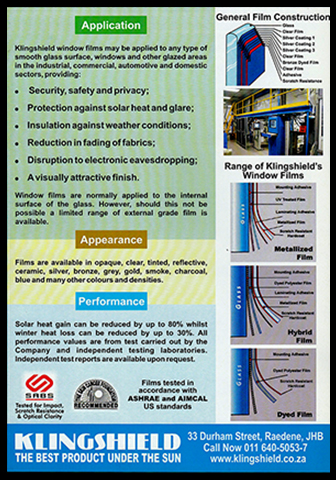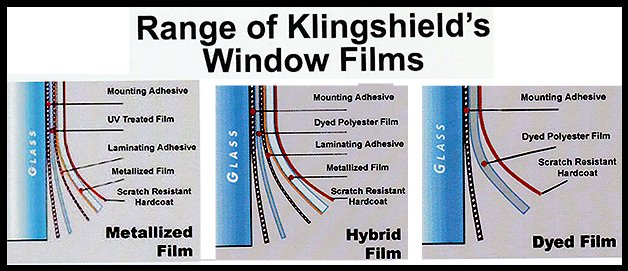Non Reflective Window Film
Non Reflective Klingshield Film
Klingshield has an extensive range of “non reflective” films from clear to heavily tinted. The reason non reflective film is made in different densities of tint, is because various films are required for various sun control problems.
Dyeing of window films started in the 60’s in the USA by a company called Martins in Virginia. This company patented a process of dyeing carpets and yarns and thereafter started dyeing polyester window films for other manufacturers. Most manufacturers at that point in time had no option but to buy their dyed films from Martins which is now known as CP Films.
These dyed films were either used on their own as non reflective films or laminated to reflective silver films to make up various coloured reflective films. The base film was supplied by ICI, Hoechst and Dupont to Martins and they dip dyed these films utilising their patent dyeing procedure.
At one point in time in the late 70’s, Martins decided and realised that the window film market was growing and they wanted to participate in this new home, office and car window film market.
Non reflective films were dyed in mainly bronze and grey tints and were available in various densities of colour from a 70% density which was very light, to a 5% density, which was the darkest.
These non reflective films are very efficient in reducing glare (visible light) as well as ultra violet light. Their performance on heat reduction is generally poor. However when a potential client wants to cut glare and ultra violet, but still requires the heat from the sun, non reflective film is utilised.
The life expectancy of a non reflective film is very limited as it only consists of one dyed film, whereas other reflective and semi reflective films consist of a lamination of many films.
All window film manufacturers in the USA utilise non reflective technology in their production lines. However, some manufacturers also use dye in their mounting adhesion to create colour.
Other manufacturers worldwide have now also started dyeing films, even in the USA as the Martins (CP) patency has now expired. Non reflective films are known as economical films as the cost to manufacture is much lower than reflective, semi reflective, high performance, sputtered or Nano technology films.
There will always be a market for non reflective films as most shopfronts need to be see through from outside and therefore cannot have any reflectivity on their windows. Most non reflective films stop 99% of the ultra violet light which is the main cause of furnishings and fabrics being destroyed by the harsh sunlight.


The high cost of spoilage resulting from the strong sun persuades retailers to apply a suitable film onto their windows. The use of non reflective window film will eliminate the need for blinds, awnings and distasteful shades and reduce fading and still allow for perfect natural vision.
The very light non reflective films are also recommended for shop windows as it does not alter the colour of articles on display. Non reflective films also come in various thicknesses as some consumers require fade resistance, glare resistance as well as excellent safety protection. Windows can shatter at any moment, causing huge damage to property and injury to personnel. Non reflective safety film will hold the glass together and reduce these risks.
Should you require any further information on this advanced engineering technique of polyester dyeing impregnation please contact our call centre 011 640 5053.
The diagram at the bottom shows in detail the makeup of the different types of film available from the Klingshield range.As can be seen, the bottom diagram,"Dyed Film",on the right hand side, is the one pertaining to the non reflective window film and tinting.
